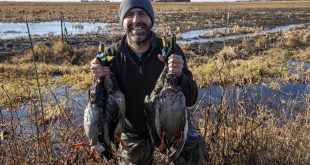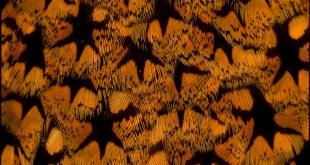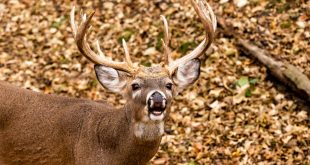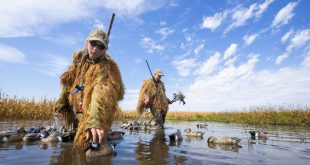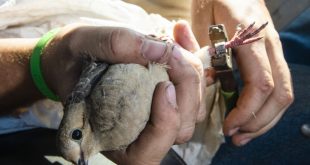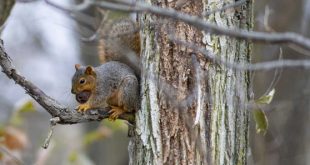An Adventure Story I had long wanted to jump-shoot ducks in the Rainwater Basin wetlands. Growing up pursuing this midday passion in Tennessee, I wanted to get back to where it all started for me: slowly working through a slough, ready at any second for a flush. With this goal in mind, I started asking questions to folks who had hunted the area. “Do that when it’s windy,” one hunter told me. “The birds will be pressed against the vegetation …
Read More »Barn Owl Rescue
An Act of Devotion Nebraska Game and Parks district offices get many calls about wildlife. The call I received about stranded baby barn owls was no exception. A rural family was getting ready to tear down a dilapidated barn on their property when they noticed a baby owl peering over a ledge near the rafters. True stewards of wildlife, they called their local Nebraska Game and Parks office to find out what they could do. Typically, this type of information …
Read More »Feathers: Nature’s Abstract Art
Nature’s Abstract Art About 20 years ago on a Sandhills hunt, I was arranging a few harvested grouse for a classic “I shot my limit” photo when I noticed something far more enticing — the feathers on the bird’s back accentuated in warm sunlight. After taking the photo, I was immediately hooked and have been photographing feather close-ups whenever the opportunity arises. For bird hunters, feathers to photograph are easy to come by. Gaudy rooster pheasants are decked out in …
Read More »Common Scents
A No-nonsense Approach to Scent Control Besides Nebraska farmers, no group in the state frets over the weather more than deer hunters. They study barometric pressure, moon phase, temperature and daylight hours, trying to figure out when deer will move and where. Of all these factors, they pay the most attention to the wind, and for good reason. While we experience the world through our eyes, deer live in a world of smell, and the wind is what delivers that …
Read More »In Pursuit of the Blue Dart
As a youngster, I cut my teeth duck hunting on small marshes in northwestern Iowa. Before the days of fancy decoys, acrylic calls, robo ducks and all the rest of modern-day technology, I would not sleep just so I could get to my favorite duck “hole.” It was there that I experienced my first encounter with this majestic bird that I would later term the “blue dart.” Although it’s been over 40 years since I harvested, or at least tried …
Read More »Dove Banding
A nationwide mourning dove banding program has been helping biologists monitor population trends of the species while also providing interesting stories of the movement and longevity of this migratory game bird. The banding program began in 2003. The information it provides, combined with more obtained from the examination of wings of harvested doves, is used to estimate the number of doves in the nation and the age structure and productivity of the population. That information, as well as hunter and …
Read More »Large Milkweed Bugs
If you pay attention to milkweed plants during the summer, you’ll notice a wide variety of insect species feeding on the nectar produced by milkweed flowers. That nectar is sweet, nutritious and free of the toxic latex found throughout most of the rest of the plant. A much smaller group of insects can be found feeding on the leaves, stems or seeds of those milkweed plants, both dealing with and taking advantage of the toxicity. Those insects include monarch caterpillars, …
Read More »Squirrel Hunting Questions
Ask yourself these questions before squirrel hunting this season. What’s Cutting? This is a squirrel hunter’s most effective knowledge base. If a hunter knows what a squirrel is eating and at what time, then their success increases exponentially. In Nebraska, squirrels eat a variety of nuts, including acorns and walnuts. A quick midday scout through the woods will reveal what nuts squirrels are cutting at a particular time, as remnants will be scattered on the ground. Partner or Alone? There’s …
Read More »Cicada killer wasps
Cicada killer wasps will start emerging from the ground anytime, but these docile wasps only have one thing on their minds: Seeking out cicadas. Found across the U.S., these native wasps start to appear in mid-to-late July through August in Nebraska. Cicada killer wasps are approximately 2 inches long with black and yellow on their abdomens and amber-colored wings. When you hear male cicadas begin singing to attract their mates, the adult cicada killer wasps will start to emerge from …
Read More »Poison ivy: Three leaves of dread
Hike for any length of time on Nebraska’s wild places and you will surely encounter the three-leaved nemesis known as poison ivy (Toxicodendron radicans). Shelley Steffl, Nebraska Game and Parks Commission private lands wildlife biologist of Chadron, often encounters poison ivy while consulting landowners on habitat projects. “Normally it’s found around more wooded areas and in places that have a little more sunshine present,” Steffl said. “Uplands, woodlands, maybe a little moister soil. It can be found in any kind …
Read More » Nebraskaland Magazine
Nebraskaland Magazine
